Bogs
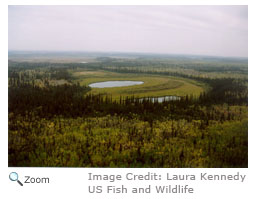 Bogs are mossy wetlands. Almost all of their water comes from rain and snow. Water in bogs is low in oxygen, very acidic and often cold! Sphagnum or peat moss is common in bogs. This moss has large cells with openings that absorb a lot of water. This makes bogs very spongy. Bogs are mossy wetlands. Almost all of their water comes from rain and snow. Water in bogs is low in oxygen, very acidic and often cold! Sphagnum or peat moss is common in bogs. This moss has large cells with openings that absorb a lot of water. This makes bogs very spongy.
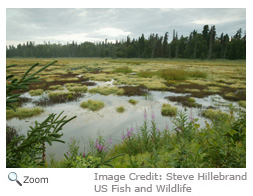 Bogs have low levels of oxygen in them because water doesn't flow in and out of them easily. Low levels of oxygen and cold temperatures make it more difficult for fungi and bacteria to decompose dead plants quickly. This helps peat form. Bogs have low levels of oxygen in them because water doesn't flow in and out of them easily. Low levels of oxygen and cold temperatures make it more difficult for fungi and bacteria to decompose dead plants quickly. This helps peat form.
 Because decomposition happens so slowly, the soil and water in bogs is very acidic. Moss and some evergreen trees and shrubs thrive in bogs because they can tolerate the acidic soil conditions. Orchids, water lilies, pickerel weed, cranberries and blueberries also grow in bogs. Because decomposition happens so slowly, the soil and water in bogs is very acidic. Moss and some evergreen trees and shrubs thrive in bogs because they can tolerate the acidic soil conditions. Orchids, water lilies, pickerel weed, cranberries and blueberries also grow in bogs.
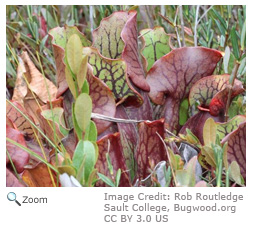 Insect-eating plants like pitcher plants and sundew often are found in bogs. They get a lot of the nutrients they need to survive from the insects they eat, so they can thrive in a bog's nutrient-poor soil. Turtles, frogs, insects and insect-eating birds are also common in bogs. There aren't many fish in bogs because of the low levels of oxygen in the water. Insect-eating plants like pitcher plants and sundew often are found in bogs. They get a lot of the nutrients they need to survive from the insects they eat, so they can thrive in a bog's nutrient-poor soil. Turtles, frogs, insects and insect-eating birds are also common in bogs. There aren't many fish in bogs because of the low levels of oxygen in the water.
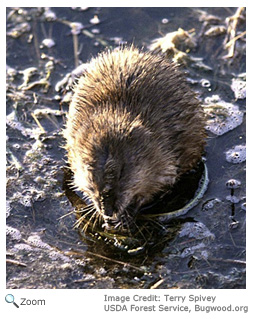 Mammals like the snowshoe hare, moose, beaver and muskrat can also be found in and around bogs. And on a gruesome note: Preserved bodies are sometimes found in bogs! Because decomposition happens so slowly, anything that falls into a bog, including animals and people, can be preserved for long periods of time! Mammals like the snowshoe hare, moose, beaver and muskrat can also be found in and around bogs. And on a gruesome note: Preserved bodies are sometimes found in bogs! Because decomposition happens so slowly, anything that falls into a bog, including animals and people, can be preserved for long periods of time!
|
|
Pocosins
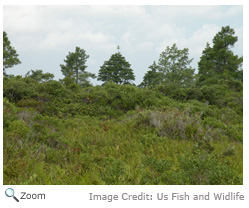 Pocosins are evergreen shrub bogs found on the coastal plains of the southeastern United States from Virginia to Florida. They are most common in North Carolina. Pocosins are often found between coastal freshwater marshes and deepwater swamp forests. There are two types of pocosins, short and tall. Short pocosins have tress that are less than 20 feet tall. Tall pocosins have trees that are over 20 feet tall. Pocosins are evergreen shrub bogs found on the coastal plains of the southeastern United States from Virginia to Florida. They are most common in North Carolina. Pocosins are often found between coastal freshwater marshes and deepwater swamp forests. There are two types of pocosins, short and tall. Short pocosins have tress that are less than 20 feet tall. Tall pocosins have trees that are over 20 feet tall.
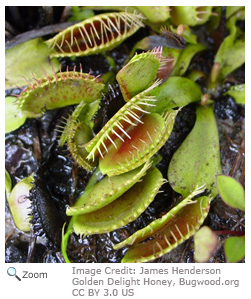 Pocosins, like bogs, have lots of sphagnum moss and nutrient-poor acidic soil and water. Like bogs, they get most of their moisture from precipitation. Evergreen plants like loblolly pine, holly, bay and pond pine are common in pocosins. The venus flytrap can also be found in the pocosin. Pocosins, like bogs, have lots of sphagnum moss and nutrient-poor acidic soil and water. Like bogs, they get most of their moisture from precipitation. Evergreen plants like loblolly pine, holly, bay and pond pine are common in pocosins. The venus flytrap can also be found in the pocosin.
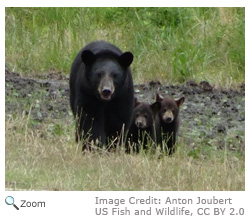 Animals in pocosins include lots of species of reptiles, amphibians and rodents as well as black bears, bobcats, bats, white-tailed deer, opossums, raccoons, river otters, mink, muskrats, northern bobwhites, and American woodcocks. Pocosins are very vulnerable to fire when they are dry. Pocosin is an Algonquin word that means "swamp on a hill." Animals in pocosins include lots of species of reptiles, amphibians and rodents as well as black bears, bobcats, bats, white-tailed deer, opossums, raccoons, river otters, mink, muskrats, northern bobwhites, and American woodcocks. Pocosins are very vulnerable to fire when they are dry. Pocosin is an Algonquin word that means "swamp on a hill."
Fens
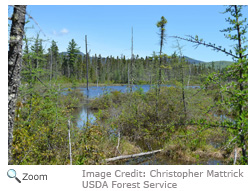 Another bog-like wetland is called a fen. Like bogs, fens formed when glaciers retreated. Grasses and sedges are common plants in fens and fens often look like meadows. They are like bogs because they have peat deposits in them, but unlike bogs some of their water comes from small streams and groundwater. The main difference between a fen and a bog is that fens have greater water exchange and are less acidic, so their soil and water are richer in nutrients. Fens are often found near bogs and over time most fens become bogs. Insects like mosquitoes and horseflies are common in fens as are amphibians, insect-eating birds and mammals like shrews, voles and muskrats.
|
 Another bog-like wetland is called a fen. Like bogs, fens formed when glaciers retreated. Grasses and sedges are common plants in fens and fens often look like meadows. They are like bogs because they have peat deposits in them, but unlike bogs some of their water comes from small streams and groundwater. The main difference between a fen and a bog is that fens have greater water exchange and are less acidic, so their soil and water are richer in nutrients. Fens are often found near bogs and over time most fens become bogs. Insects like mosquitoes and horseflies are common in fens as are amphibians, insect-eating birds and mammals like shrews, voles and muskrats.
Another bog-like wetland is called a fen. Like bogs, fens formed when glaciers retreated. Grasses and sedges are common plants in fens and fens often look like meadows. They are like bogs because they have peat deposits in them, but unlike bogs some of their water comes from small streams and groundwater. The main difference between a fen and a bog is that fens have greater water exchange and are less acidic, so their soil and water are richer in nutrients. Fens are often found near bogs and over time most fens become bogs. Insects like mosquitoes and horseflies are common in fens as are amphibians, insect-eating birds and mammals like shrews, voles and muskrats.







